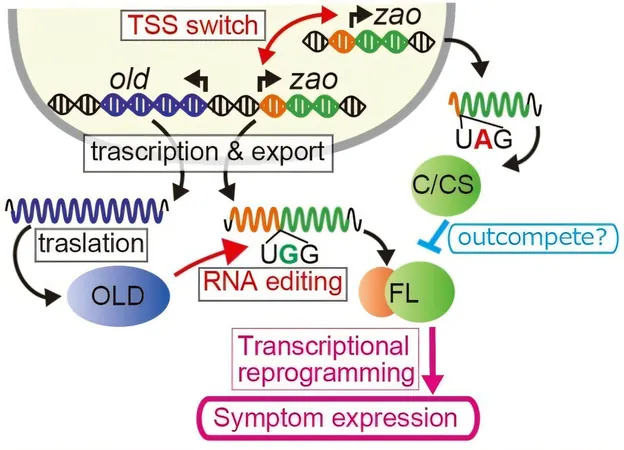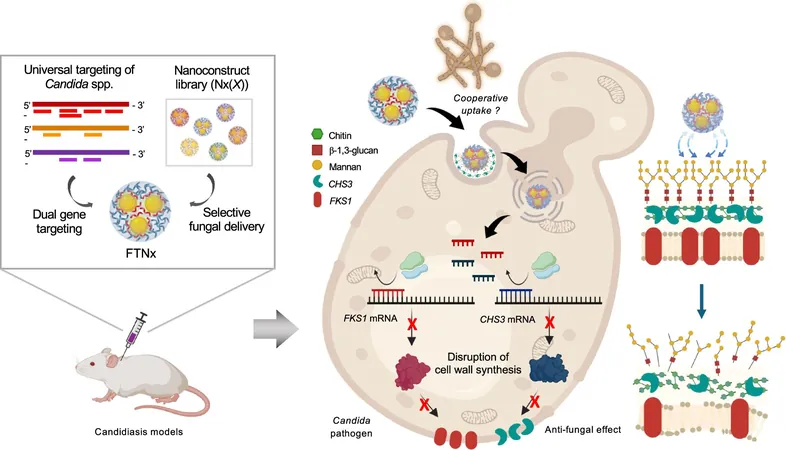
Unraveling the Fungal Shield: How Fungi Use RNA Editing to Combat Viruses
2025-05-23
Author: John Tan
A Mysterious Battle: Fungi vs. Viruses
The world of fungi is more than just mushrooms and mold; it’s a battleground against hidden viral foes. Typically, viral infections within fungi don’t lead to visible symptoms, leaving scientists baffled about the underlying mechanisms at play in these enigmatic fungus-virus interactions.
The Arsenal of Fungal Defense
Fungi deploy several tactics to fend off viral attacks: RNA interference (RNAi) to hinder virus replication, transcriptional reprogramming to adjust their genetic response, and a unique ability to differentiate between self and non-self elements to contain viral spread. However, the intricacies of how these strategies induce or suppress symptoms remain largely unexplored.
Breaking New Ground with Japanese Research
To unravel this complex web, a team of researchers from Japan, led by Associate Professor Shinji Honda of Fukui University, has taken pioneering steps. Their groundbreaking study, published in *Cell Host & Microbe*, reveals how fungi like *Neurospora crassa* use RNA editing as a weapon in their antiviral arsenal.
RNA Editing: A Game Changer in Fungal Defense
In their experiments, the researchers discovered that A-to-I RNA-editing enzymes ramp up in response to viral infections. These enzymes modify messenger RNA (mRNA) of key transcription factor genes crucial for the fungal defense mechanism. Their findings shine a light on the significant role played by RNA editing in determining whether a fungus will show symptoms.
The Intriguing Case of Neurospora and Its Viruses
Their focus was on *Neurospora crassa*, particularly a virus called Neurospora crassa fusarivirus 1 (NcFV1), which usually remains silent in healthy strains but wreaks havoc in RNAi-deficient mutants. This interplay between the virus, its host's genetic makeup, and the resulting symptoms unveils a mesmerizing dance of survival.
Gene Interactions: The Key Players Revealed
Through mutational analysis, the team uncovered two vital genes, old-1 and old-2, that harbor deaminase domains essential for editing processes. The genomic regions targeted by these genes were identified, leading to groundbreaking insights into how these fungi translate viral threats into cellular responses.
When Defense Systems Fail: The Fallout
In a fascinating twist, the absence of the RNAi system led to dramatic changes in gene expression. The deletion of gene zao-1 resulted in pronounced symptoms during viral infections, while a further deletion of zao-2 surprisingly restored an asymptomatic state, revealing the delicate balance fungi maintain in their defense responses.
A Complex Web of Regulation
The researchers suggest that shorter variants of the ZAO-1 protein compete with full-length variants for DNA binding, a mechanism that helps maintain a tranquil state during infections. When this balance tips, it unleashes a cascade of transcriptional activity that can culminate in severe symptoms.
Evolutionary Insights into Fungal Defense
Additionally, phylogenetic analyses indicate that these RNA editing mechanisms are evolutionarily conserved across various fungal species. This realization opens up new avenues for genetic engineering in fungi, potentially leading to strains with enhanced antiviral capabilities.
Conclusion: A New Chapter in Fungal Virology
Dr. Honda's team has embarked on a journey that highlights the intricate layers of fungal defense, intertwining RNA editing, transcriptional reprogramming, and a newly discovered genomic regulation mechanism. This research not only offers profound insights into fungus-virus interactions but also holds promise for innovative applications in biotechnology and agriculture, paving the way for creating robust fungal strains with antiviral potential.




 Brasil (PT)
Brasil (PT)
 Canada (EN)
Canada (EN)
 Chile (ES)
Chile (ES)
 Česko (CS)
Česko (CS)
 대한민국 (KO)
대한민국 (KO)
 España (ES)
España (ES)
 France (FR)
France (FR)
 Hong Kong (EN)
Hong Kong (EN)
 Italia (IT)
Italia (IT)
 日本 (JA)
日本 (JA)
 Magyarország (HU)
Magyarország (HU)
 Norge (NO)
Norge (NO)
 Polska (PL)
Polska (PL)
 Schweiz (DE)
Schweiz (DE)
 Singapore (EN)
Singapore (EN)
 Sverige (SV)
Sverige (SV)
 Suomi (FI)
Suomi (FI)
 Türkiye (TR)
Türkiye (TR)
 الإمارات العربية المتحدة (AR)
الإمارات العربية المتحدة (AR)